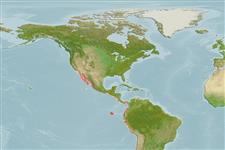Classification / Names
Common names from other countries
Main reference
Size / Weight / Age
Max length : 106 cm TL male/unsexed; (Ref. 55763); common length : 20.0 cm TL male/unsexed; (Ref. 9301)
Environment
Marine; pelagic-neritic
Climate / Range
Tropical, preferred ?; 34°N - 17°S, 121°W - 71°W
Distribution
Eastern Pacific: Southern California, Gulf of California and the western coast of Baja California, Mexico to Peru, including many offshore islands.
Countries | FAO areas | Ecosystems | Occurrences | Introductions
Short description
Dorsal
spines
(total): 0;
Dorsal
soft rays
(total): 17-20;
Anal
spines: 0;
Anal
soft rays: 16 - 19;
Vertebrae: 75 - 76. Rows of spinules in skin easily seen but individual spinules difficult to discern. Color in life orange to red above, with brownish and black blotches. Lighter below. Dorsal and anal fins with orange bases. Caudal filament dusky (Ref. 9826). Branchiostegal rays: 5 (Ref. 36710).
IUCN Red List Status (Ref. 115185)
Threat to humans
Harmless
Human uses
Fisheries: subsistence fisheries
More information
ReferencesAquacultureAquaculture profileStrainsGeneticsAllele frequenciesHeritabilityDiseasesProcessingMass conversion
Tools
Special reports
Download XML
Internet sources
Estimates of some properties based on models
Phylogenetic diversity index
PD50 = 0.6250 many relatives (e.g. carps) 0.5 - 2.0 few relatives (e.g. lungfishes)
Trophic Level
4.5 ±0.80 se; Based on food items.
Resilience
Vulnerability
Moderate to high vulnerability (45 of 100)
Price category
